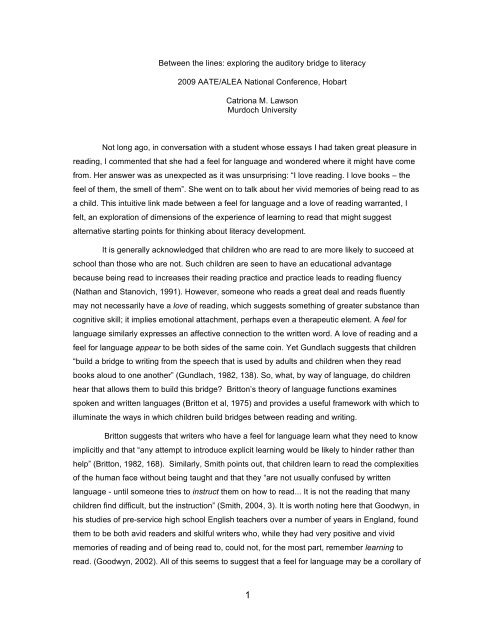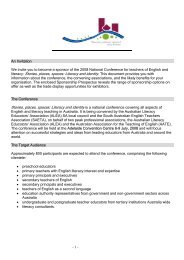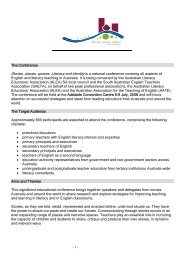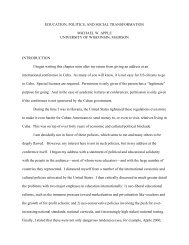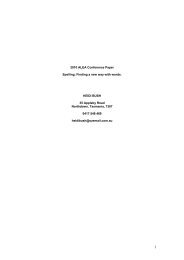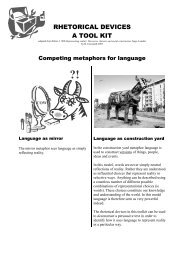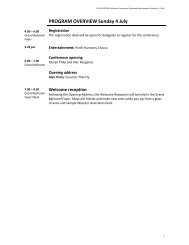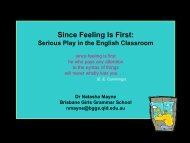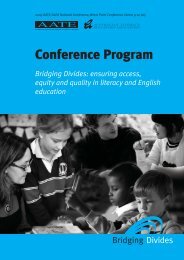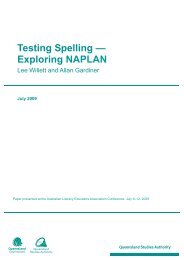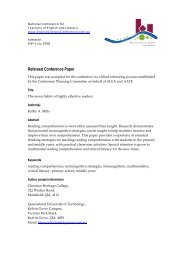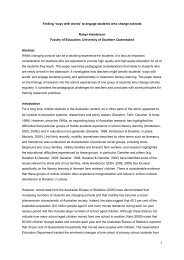Catriona Lawson - AATE/ALEA National conference
Catriona Lawson - AATE/ALEA National conference
Catriona Lawson - AATE/ALEA National conference
You also want an ePaper? Increase the reach of your titles
YUMPU automatically turns print PDFs into web optimized ePapers that Google loves.
Between the lines: exploring the auditory bridge to literacy2009 <strong>AATE</strong>/<strong>ALEA</strong> <strong>National</strong> Conference, Hobart<strong>Catriona</strong> M. <strong>Lawson</strong>Murdoch UniversityNot long ago, in conversation with a student whose essays I had taken great pleasure inreading, I commented that she had a feel for language and wondered where it might have comefrom. Her answer was as unexpected as it was unsurprising: “I love reading. I love books – thefeel of them, the smell of them”. She went on to talk about her vivid memories of being read to asa child. This intuitive link made between a feel for language and a love of reading warranted, Ifelt, an exploration of dimensions of the experience of learning to read that might suggestalternative starting points for thinking about literacy development.It is generally acknowledged that children who are read to are more likely to succeed atschool than those who are not. Such children are seen to have an educational advantagebecause being read to increases their reading practice and practice leads to reading fluency(Nathan and Stanovich, 1991). However, someone who reads a great deal and reads fluentlymay not necessarily have a love of reading, which suggests something of greater substance thancognitive skill; it implies emotional attachment, perhaps even a therapeutic element. A feel forlanguage similarly expresses an affective connection to the written word. A love of reading and afeel for language appear to be both sides of the same coin. Yet Gundlach suggests that children“build a bridge to writing from the speech that is used by adults and children when they readbooks aloud to one another” (Gundlach, 1982, 138). So, what, by way of language, do childrenhear that allows them to build this bridge? Britton’s theory of language functions examinesspoken and written languages (Britton et al, 1975) and provides a useful framework with which toilluminate the ways in which children build bridges between reading and writing.Britton suggests that writers who have a feel for language learn what they need to knowimplicitly and that “any attempt to introduce explicit learning would be likely to hinder rather thanhelp” (Britton, 1982, 168). Similarly, Smith points out, that children learn to read the complexitiesof the human face without being taught and that they “are not usually confused by writtenlanguage - until someone tries to instruct them on how to read... It is not the reading that manychildren find difficult, but the instruction” (Smith, 2004, 3). It is worth noting here that Goodwyn, inhis studies of pre-service high school English teachers over a number of years in England, foundthem to be both avid readers and skilful writers who, while they had very positive and vividmemories of reading and of being read to, could not, for the most part, remember learning toread. (Goodwyn, 2002). All of this seems to suggest that a feel for language may be a corollary of1
a love of reading and that a love of reading cannot explicitly be taught but may be learnt byexperience. It does little, however, to illuminate what exactly is learnt and experienced.Doris Lessing, in her Nobel Prize acceptance speech, stated that “writers do not comeout of houses without books” (Lessing, 2007). This is rather a bold statement. There must, surely,be writers of note whose childhood was bereft of books: Frank McCourt, for example, whosebook, Angela’s Ashes, describes the searing poverty of his early life. Yet he says, “...when youhave nothing, little things become very precious, like books. There was an occasional book thatcame into our house and we just devoured it… I can remember all of them, even the look of themand the smell of them” (http://www.achievement.org/). He continues, “...my father ...would tell usstories and teach us songs... My mother was a good storyteller too...I remember [the] fire, lookinginto the flames darting and leaping, and she's telling the story and we're having tea”(http://www.achievement.org/). Cullinan says that “[s]tory has great power in human lives. Weknow that it is a primary act of mind; it is the way we organize our minds and understand ourworld" (Cullinan, 1989, 50). Nathan & Stanovich state that “stories help create an interest inbooks” (1991, 179).It seems clear that stories and books are powerful stimuli, but to suggest that hearingstories encourages reading is problematic, if only because all cultures tell stories (e.g. Minami,2002) but not all cultures are written cultures. Bus and van Ijzendoorn (1995, 998) suggest thatinterest in reading “is not a natural phenomenon but rather is evoked by the pleasure of sharing abook with the parent.” Smith, however, says there is nothing unnatural about it. What is natural isto try to make sense of the world, and “making sense of print [is no] more complicated thanmaking sense of speech” (Smith, 2004, 4). Nevertheless, if story-telling and being read to areassociated with making sense of the world in a pleasurable way, what sets story-language apartfrom everyday language to such an extent as to create the impetus to engage in reading forpleasure?Britton (1982) differentiates between the functions of language. He formed his discoursetheory from studies on language development and from Halliday’s (1973) functionalist theory, anddistinguishes between the roles of participant and spectator in an event, relating these two rolesto the ways in which we talk about ourselves. To invite our listeners to share with us ourpleasures and misfortunes, our past experiences, our dreams of the future and our gossip, and toexpress our opinions and our attitudes, we talk as spectators, using the unstructured expressivediscourse of the shared context. When we want to get something done, to inform or to convey ourideas, we talk as participants, using a transactional form of discourse to invite our listeners toparticipate with us in achieving our ends (Britton, 1982). This function embraces the practical tothe abstract dependant on how far it is removed from immediate experience (Durst and Newell,1989). There is a third discourse function, the poetic, which is the preserve of literature and2
poetry and which Britton describes as “the form that most fully meets the demands associatedwith the role of spectator...by MAKING something with language rather than DOING somethingwith it” (Britton 1982, 155).Britton argues that underpinning any text is the speaker’s need to make his/her intentclear to the listener. Since vocabulary and syntax alone may be ambiguous, a speaker willunderpin the text with acoustic features such as pitch, contour and timbre. The intent of an adultwho speaks to an infant is often to give pleasure or to soothe, an intent closely allied to the poeticfunction, where language is used both to represent an experience and to create, in the listener, avirtual experience (Durst and Newell, 1989). A child hearing such infant directed speech will hearlanguage that differs markedly from that of everyday transactional or expressive discourse, andowes much more to the poetic, or even musical, by way of its variation in melodic contour.It is well established that infants are sensitive to musical qualities even three monthsbefore birth (Papoušek, M., 1996). A baby’s musical ‘ear’, in utero, is mature enough to responddifferently to contrasting musical styles (Lynch et al, 1995) and can differentiate speech frombackground noise (LeCanuet, 1996). Infants are well prepared as auditors of the prosodic ormusical aspects of speech. They do not understand the words but they hear adults talk to them inways that are “drenched in musicality” (Fox, 2000, 24). Elements such as melodic contour, pitch,rhythm and meter, harmony and timbre are all features of the adult’s utterances. The pitch israised, the tempo is slowed and speech segments are shorter, more repetitive and more welldefinedin broad melodic contours than in adult directed speech (Fermald and Simon, 1984;Papoušek, M., 1996). The timbre, or tonal colour, is warm; the 'edges' are softened to avoidgiving any inkling of alarm. At the same time, infants, far from being passive recipients of thismusical stimulation, engage as active participants (Sloboda, 2004). Within eight weeks or so thebaby is able to control her rate of breathing to produce prolonged cooing and, over the followingmonths, her repertoire of utterances becomes tuned to the vowel sounds and rhythms of hermother tongue (Garbarino et al, 1992; Papoušek, H., 1996). Both caregiver and infant matcheach other’s vocalisations in what appears to be a reciprocal exchange (Piaget, 1962; Papoušekand Papoušek, 1989, Papoušek, M., 1996). As the interactions become more complex, itbecomes increasingly difficult to detect who is imitating whom in the prosodic duet.This early music education has been found to be universally present across cultures –though not consistently present amongst caregivers. Studies (e.g. Snow, 1989, Papoušek andPapoušek, 1991) have shown that auditory feedback in the form of parental imitation of infantvocalisation encourages infants to practise controlling the prosodic elements of speech and thatthe infant’s later rate of lexical imitation is predicated on the frequency of reciprocal vocalmatching in the early months (Papoušek and Papoušek, 1989). To make meaning from speech,infants need to be able to segment what they hear into units and then determine which units3
correspond to a particular meaning they experience. A number of studies (e.g. Stern et al, 1982;Jusczyk and Krumhansl, 1993) have demonstrated that infants parse their caregivers’ speech insyntactic units like phrases and clauses, and that they do this by using prosodic information.Prosody is central to understanding spoken language (Frazier et al, 2006) and parents intuitivelyuse musical vocal play as a means of teaching infants how to use dialogic skills (H. Papoušek,1996). Since prosody is prominent in infant-directed speech and infant directed speech displaysuniversal prosodic elements (Grieser and Kuhl, 1988), there may be some biologicalpredisposition for the perception of melodic contour in reciprocal parent-child interaction. (M.Papoušek, 1996; Fassbender, 1996, Levitin, 2006).Singing, too, is common amongst caregivers in all cultures and, in almost all cultures,movement is integral to making and listening to music (Levitin, 2006), so language learning, formost young children, is a musical experience; elongated vowels, extravagant intonation,repetition, musical games and rhythm foreshadow the onset of infant rhythmical, repetitivebabbling of syllables that appear to be common to all languages (e.g. dadada; mamamam) andlie somewhere between song and nascent language (Jourdain, 1997). According to theconstructivist theory of meaning-making (e.g. Bruner, 1966), making sense of something is amatter of relating it to what is already known and has become part of long-term memory. Makingsense of language and music is no different. Prosody is the “skeletal frame” of language (Frazieret al, 2006, 248) which, through frequent exposure, becomes fixed in long-term memory allowingthe child to become familiar enough with the syntactical structure of the mother tongue to be ableto predict characteristic patterns of the language (Levitin, 2006; Frazier et al, 2006).Children across all cultures are exposed, almost exclusively in their early months, to theprosody of infant directed speech, the contours and rhythms of which are more akin to Britton’spoetic discourse, in that they represent the experience rather than describe it. However,children’s first words signal a change; “they seem to open the way for verbal, rational, conscious,and culture-dependant guidance” (Papoušek, 1996, 48). Thenceforth they hear, almostexclusively, the everyday language of transactional and expressive discourse as they learn toparticipate in, and spectate on, their social lives – that is, unless they are read to.Children whose parents read regularly to them hear the sound of the written languagewhen it is read aloud. This is quite different in pitch, tempo, timbre, rhythm and contour from thespoken language, if it is done well. In other words, a parent needs to perform rather than to read.The child who hears a parent make something of the language by reading aloud with a voice thatexpresses the prosody of the narrative written text maintains a continuity of connection with thevoice of poetic discourse, first heard through infant directed speech, nursery rhymes andlullabies. She comes to know the sound of written text and, through the reader’s oral‘transcription’ of highly structured syntactic groups (Guaïtella, 1999), she can hear the4
segmentation of text into clauses and sentences; she hears punctuation. The very nature of mosttransactional and expressive speech precludes segmentation into intonation units, imbued as it iswith hesitation, stutters, repetitions, false starts and unfinished sentences (Cruttenden, 1986).Breathing, which is both a limiting and a contributory factor in spontaneous speech, is“neutralized in a reading aloud context because of its positioning with respect to punctuation”(Guaïtella, 1999, 518). On the other hand, gesture and facial expression, which play active rolesin the rhythmic organisation of speech, exist in the context of reading aloud simply to addtheatricality. The primary medium of language is sound and the prosodic features of language,including written language, need to be heard if the writer’s intent is to be understood. By hearingthe written language read aloud, a child begins to develop an ‘inner voice’ and learns to manageprosodic phrasing along with its associated punctuation (Chafe, 1987). As a consequence of this“apprenticeship of listening to others” she learns, as a writer, to listen to her inner voice “dictatingto h[er] the story [s]he wants to produce” Britton (1982, 167). The extent of her ability to nurtureher inner voice may have a substantial influence on her later capacity to write effectively.Children are active in developing their inner voices. They ask for the same stories to beread again and again. Furthermore, they expect those stories to be read in the same mannereach time. As anyone who reads regularly to a child will attest, the listener will readily pounce onand correct the reader’s error whether it be a missed or misspoken word or a matter of intonation– getting the ‘voice’ wrong. “Expressive reading is remembered” (Fox, 2001, 21) but while theauditory aspect of narrative text may be crucial to the development of an inner voice and thence afeel for language, it does not account for a love of reading. A child may take great pleasure frombeing read to and from the conversations that go on during readings, but reading inevitablybecomes a solitary activity. If a child is to become fluent beyond the level of children’s stories – toextend the ‘growing edge’ (Bereiter & Scardamalia, 1993), he or she will necessarily read and,more importantly, want to read more and more complex texts.Infant directed speech consists of “prototypical contours” (Papoušek, 1996, 94), thefrequent repetition of which allows infants to perceive, anticipate, answer and, ultimately, controlthe maternal music (Papoušek, H. 1996). Similarly, children’s texts follow repetitive prototypicalpatterns. Nursery rhymes, for example, introduce children to the timbral repetition of rhyme,assonance and alliteration. Fairy stories begin with “Once upon a time” and end in “And they alllived happily every after” (or their equivalents in other languages). Children do not find theserepetitions tedious. They know what to expect and can anticipate, particularly if a parentrepeatedly reads the same book in the same expressive way. Repetition, far from leading tohabituation and desensitisation as one might expect, is experienced as being pleasurable. If thisseems counterintuitive, it should be noted that there is “probably no other stimulus in commonhuman experience that matches the extreme repetitiveness of music” (Huron, 2007, 141). Thesame parts of the brain process all sounds, including speech. However, patterned variations in5
pitch, rhythm and timbre engage other parts that are involved in feelings of pleasure (Levitin,2006). The voice of expressive reading aloud is rich in melodic variation and contrasts of timbre.The more the child experiences being read to, the greater will be the strength of the memorytrace for that experience and its associated feelings of pleasure. Such a child may develop a loveof reading and may even attribute feelings of pleasure to the representation of the stimulus(Huron, 2007): the book itself, the look of it, the feel of it and the smell of it. It is not unreasonableto suggest that books can be transition objects (Winnicott, 1953), tangible manifestations of thelove between parent and child when discourse is at its most poetic, that allow the child to build abridge between home and school and to develop an independent existence, while still being ableto find comfort during moments of anxiety.By the time she reaches school, a child who has been read to regularly may have asmuch as three hundred hours’ head start in listening experience over a child who has not beenexposed to written texts. Experience itself, of course, is not a guarantee of improved performance(Ericsson & Lehmann, 1996). More significantly, a child who has been read to expressively islikely to know the pleasure to be had from reading, to care about reading as something important,perhaps even to have acquired a taste for a particular type of book or story, to be motivated topractise, and to be able to hear the sound of the written language as distinctive. It is with thesefactors in mind that it is necessary to address what may happen where their importance isunderestimated and where reading is treated as a predominantly visual experience, for examplesound/symbol connection or emphasis on pictures and the look of the page.The “Big Book”, intended to be “the classroom equivalent of twenty or more children on[the teacher’s] lap at one time!” (Parkes, 2000,13) may be such a case. The notion that a childcan join in shared reading from the first day of school is very appealing. However, for the novice,it may be counterproductive. The model of shared reading is based on Holdaway’s (1979)observations of early readers whom, he noted, had been read to regularly at home, had spenttime by themselves with books, and whose parents had provided them with scaffolded readingopportunities. Since not all children would have had these opportunities, teachers, Holdawaybelieved, could compensate by creating the same conditions in the classroom. Children sittogether on a mat in front of the teacher who holds the Big Book. All children are able to see thebook and the pictures while the teacher enthusiastically models the reading process. Typically, onrereading the book, the teacher encourages the children to join in and the conversationafterwards focuses on textual features and reading strategies (Holdaway, 1979).This is not the experience created for the child who has been read to in the peace andquiet of home and who undertakes an “apprenticeship of listening”, hearing the poetic discourseof stories read many times and in the same way without expectation of transactional participation.The novice in the classroom hears the voice of the teacher accompanied by the ragged chorus of6
his peers as well as the inevitable shuffle of children sitting on the floor. The classroom, too, maybe brightly decorated, designed to catch the eye but not the ear of the children. Amidst thisbackground clamour, the ear may have difficulty in becoming attuned to the nuances andprosodic elements of poetic discourse. For some children, prosody and timbre may be significantbarriers to building a bridge to literacy.Children from non-English speaking backgrounds are accustomed to the rhythms andcontours of their mother tongues. If they arrive speaking little or no English at all, they mayremain silent for some time as they tune their ears, not just to the vocabulary, but also to theprosody of the new language. It may not take them long to acquire the day-to-day languagerequired for survival, but they must carry the double burden of learning to hear and differentiate,virtually simultaneously, the prosody of both the transactional and expressive discourses withtheir contractions, abbreviations and elisions and of the poetic discourse, whose Standard writtenEnglish, by and large, outlaws such informality.In Australia, English-speaking Indigenous children face, perhaps, greater difficulty simplybecause it is assumed that they speak the common language. However, the prosody ofAboriginal Australian English is very different from that of Anglo-Australian English. For example,in Aboriginal Australian English there is a tendency to shorten vowels, to stress the first syllableand to employ long inter-turn pauses, differences that may have “a serious detrimental outcomeon speech events in which European Australian conventions are dominant” (Kachru, Kachru andNelson, 2006, 81) As a consequence, Indigenous students may endure many of the samedifficulties as migrant students, but, possibly, with less teacher sympathy and understanding.For quite different reasons, boys, too, may not have adequate opportunity to accesspoetic discourse. In a culture where boys are expected to go outside and play, the pitch, rhythmand timbre of language that their ears become attuned to is likely to be associated withtransactional discourse. A backyard game of football will elicit prosody far removed from that ofthe bedtime story. Moreover, if the prosody of poetic discourse is associated with the femininevoices of mother and female teacher and the more pleasurable prosody of transactionaldiscourse is associated with the masculine voices of father and male sports coach, for example,reading may become a gender issue unless, perhaps, boys are exposed to transactional texts -non-fiction - read aloud as though they were narratives, using the prosodic features of poeticdiscourse.It is interesting to note that these three groups of children are those who seem least ableto build a bridge to literacy (e.g. AASW, 2000). Solutions are proffered that generally involvesome form of ‘guided’ reading practice for the struggling or reluctant reader and that invariablyfocus on the visual; graphic novels, phonics; large print books. Children who have been read tohave enjoyed hours and hours of stress-free practice in listening to highly expressive and poetic7
discourse. On the other hand, the struggling reader, whose ‘ear’ has been inadequately tuned,may be taken to the ‘wet area’ or the veranda to be listened to for fluency and comprehension asa participant in the transactional discourse between judge and judged. Where is the pleasure inthat?Even more experienced listeners may detect that the poetic discourse that is a salientpart of reading at home has begun to take on a more transactional tone at school. Story canbecome something that is done, rather than enjoyed. Children may be asked to respond in writingto stories they have heard, perhaps rewriting the ending. Children do not yet have the tools towrite or rewrite the highly-evolved art form that is narrative. The inner voice that is nurtured bymany hours of experience in hearing the poetic discourse has barely begun to whisper. Youngchildren know this and, despite teachers’ best efforts, they focus on those elements of writing thatare within their control, recognising “good” writers as being those whose spelling is accurate andwhose handwriting is legible rather than who is the most imaginative (Kos and Maslowski, 2001).Stories are often used to introduce children to ‘story grammar’ and other elements ofnarrative. However children learn to understand language just by being exposed to it. They areable to “generate sentences without any formal training in [the] underlying rules” (Jourdain, 1997,275). Similarly, they learn generic structure by repetitive exposure and are well versed in themore everyday genres of recount and instruction having been told what happened and what to dofor most of their lives. In fact, studies have found that children prefer to write more transactional(informational) texts at school (Newkirk, 1987) and that even adults prefer to confine theexpressive and poetic functions to their private writing and to a time of their own choosing(Schreiner, 1997).Britton believed that the expressive function, being most closely related to children’s earlylanguage, should be encouraged in their writing since it would act as “a kind of matrix from whichdifferentiated forms of mature writing developed” (Britton et al, 1975, 83) but there is littleevidence to support this claim (Durst and Newell, 1989). On the contrary, in the absence ofhearing the sound of more complex patterns, the expressive function has come into its own. Bestunderstood as the function that corresponds to “informal talk among friends, where the rules ofuse are relaxed” (Durst and Newell, 1989, 378), expressive discourse is the lingua franca ofYouTube, FaceBook, MySpace and Twitter. The written equivalent of the oral language has beendeveloped, with all its hesitations, repetitions, contractions, abbreviations and elisions. It is similarto young children’s writing in that it includes non-linguistic features, emoticons, for example.Punctuation is, by and large, dispensed with, except as a means of signifying gesture andemotion, the smiley. Being exposed, daily, to the three-line paragraph of the Internet, the efficientspelling of the text message, the verb-less grammar of the news headline and oral phrasingdictated by the teleprompter, current generations are communicating effectively with each other8
with an alacrity undreamt of by previous generations through “a context of shared interests,mutual experience, and common goals and objectives" (Applebee, 1978, 6).Reading, however, is not a social activity. A shared context cannot be assumed in theclassroom either between students and teacher or amongst students. A study conducted inAmerica of over 17,000 students on their attitudes to reading (McKenna, Kear and Ellsworth,1995) showed all children, regardless of reading ability, gender and ethnicity, to have a positiveattitude to reading and learning to read before entering Grade 1. By the time the children reachedGrade 6, their positive attitude had declined, in some cases precipitously, but with a notableexception. While there was an overall decline in attitude towards academic reading, attitude torecreational reading declined considerably less steeply amongst high-ability readers in generaland amongst high-ability girls in particular. Furthermore, no significant difference was foundamongst students whose teachers had relied heavily on basal readers for reading instruction andthose who had used literature. Another American study, (Pressley, Rankin and Yokoi, 1996)showed that reading aloud by teachers rapidly drops from almost daily in pre-primary to aroundmonthly in Grade 2. It is possible that, with respect to recreational reading, high-ability readers,already accustomed to reading for pleasure, continue to read in spite of school, whereas novicereaders may have some early inkling that there is pleasure to be had from reading but discoverthat it is increasingly beyond their grasp as they are exposed progressively less frequently to thesound of poetic discourse read aloud.The auditory bridge to poetic discourse is not new; Stories of the Dreaming, Biblereadings in church, recitations of the Qur’an, Children’s Hour on the radio are all examples oflanguage heard by children at its most expressive. However, building an auditory bridge toliteracy depends, first of all, on creating the conditions in which inner voices may be nurtured,which is to say, generating repeated hearings of poetic discourse spoken beautifully against abackground of quiet and an absence of visual distraction. Children who are read to at home byadults who do it well experience a long apprenticeship of listening to the sounds of the writtenlanguage and, equally important, of hearing those sounds spoken in a timbre that evokes analmost visceral pleasure. Just as we develop a preference for musical sounds that we have heardin infancy (Jourdain, 1997), so we may develop a preference for the vocal quality epitomised by aparent’s reading. Language, as something that is heard, is “fundamentally a system of timbralcontrasts [and the] human voice is the supreme instrument of timbral contrast (Patel, 2008, 51).However, some instruments seem to find more universal favour than others, as is evident fromthe inability of a number of ‘silent’ film stars to make the transition to ‘talkies’. The timbral qualityof the voice may, to an extent, be controlled at any given moment but the timbral quality of theoverused, untrained voice is likely to suffer over time. Yet, of all public speakers, teachers areleast likely to have been taught how to use their voices. Teachers’ vocal impairment due to lackof voice training has been shown to have a detrimental effect on children’s speech perception9
(Rogerson and Dodd, 2005). It is possible, therefore, that a teacher’s lack of training in readingaloud may have a detrimental effect on children’s perception of the sound of the written language.If this is coupled with an ear ill-attuned to the nuances of poetic discourse, the listener’s pleasureis unlikely to be aroused. Moreover, since nuance can be communicated only by demonstration(Sloboda, 2004), the novice reader, in the absence of an adequate model, may find it onerous to‘play read’, unable to develop a feel for, and practise control of, the prosodic elements of thewritten language and to nurture the writer’s inner voice.This may strike a dissonant chord with the contemporary perception of classrooms ascolourful, collaborative places, which has arisen out of the social, functionalist tradition oflanguage associated with, for example, Jakobson (1960) Halliday (1978) and Britton et al (1975).However, if, as this paper argues, the bridge to literacy is an auditory one, perhaps it would beuseful to alter Britton’s ‘spectator’ role to that of ‘auditor’ and to focus on what students hear byway of literacy, how often and how well. It is possible that the reluctant or struggling reader hashad an insufficient apprenticeship in listening and is being distracted by the bright, print-richenvironment of the contemporary classroom, misled by the notions that interaction andengagement with text are the same as reading and that ‘silent’ reading is the mute decoding ofprint rather than an opportunity for pleasurable internal discourse. A warm, softly lit, quiet readingarea; a large comfortable couch; and a child on either side of an adult or older child who readsbeautifully are much closer to the home experience where a love of reading and a feel forlanguage are cultivated over time.No one, thank God, killed the language or mutilated the literature I loved byhacking it into little pieces and teaching it to me little bit, by little bit. No! I wasinstead blessed many times over by having people read aloud to me. Mymother and my father, my teachers and my professors all poured into mywilling ear the finest prose, the most glorious stories, the most uplifting verse,and the most inspiring drama written in the English language. My ear was myteacher.Mem Fox (www.memfox.com/green-sheep-secrets.html)10
REFERENCESAcademy of Achievement (1999) Frank McCourt. Retrieved 16 March 2008 fromhttp://www.achievement.org/autodoc/page/mcc1int-1Applebee, A. N. (1978). The child's concept of story. Chicago: University of Chicago PressAustralian Association of Social Workers (2000). The Education of Boys. Submission to theHouse of Representatives Standing Committee on Employment, Education and WorkplaceRelations. http://www.aasw.asn.au/adobe/advocacy/inquiry_education_of_boys.pdf.Accessed 13 May 2009Bereiter, C., & Scardamalia, M. (1993). Surpassing ourselves: An inquiry into the nature andimplications of expertise. La Salle, IL: Open Court.Britton, J.N. (1982) Spectator Role and the Beginnings of Writing. In M. Nystrand (Ed.), WhatWriters Know. (pp 149-169). New York: Academic Press Inc.Britton, J.N., T. Burgess, M. Martin, A. McLeod and H. Rosen (1975) The development of writingabilities. London: MacmillanBruner, J. (1966). Toward a Theory of Instruction. Cambridge, MA: Harvard University Press.Bus, Adriana G. and Marinus H. van Ijzendoorn. 1995. Mothers Reading to Their 3-Year-Olds:The Role of Mother-Child Attachment Security in Becoming Literate. Reading ResearchQuarterly, 30 (4): 998-1015. JSTOR. http://www.jstor.org/ (accessed: 22 January 2007)Chafe, W. (1988). Punctuation and the prosody of written language. Written Communication, 5,396-426.Cruttenden, A., (1986). Intonation. Cambridge: Cambridge University Press.Cullinan, B.E. (1989). Literature for young children. In D. Strickland & L.M. Morrow (Eds.),Emerging literacy: Young children learn to read and write (pp. 35-51). Newark, DE:International Reading Association.Durst, R.K. and Newell, G.E. (1989) The Uses of Function: James Britton's Category System andResearch on Writing. Review of Educational Research, 59, (4), 375-394http://www.jstor.org/stable/1170204 (accessed: 07 July 2008)Ericsson, K. A., and Lehmann, A. C. (1996). Expert and exceptional performance: Evidence onmaximal adaptations on task constraints. Annual Review of Psychology, 47. 273-305.Fassbender, C. (1996) Infants' auditory sensitivity to acoustic parameters of speech and music. InI. Deliège and J. Sloboda, (Eds), Musical beginnings. Oxford: O.U.P.Fernald, A., and Simon, T. (1984). Expanded intonation contours in mothers’ speech tonewborns. Developmental Psychology, 20, 104–113.Fox, D. B. (2000) Music and the Baby's Brain: Early Experiences. Music Educators Journal, 87,(2), 23-27+50Fox, M. (2001) Reading Magic: Why Reading Aloud to Our Children Will Change Their LivesForever. New York: Harcourt Inc.Fox, M. (2009) Mem Fox; teaching, learning, living. Retrieved 14 January, 2009 fromhttp://www.memfox.com/Frazier, L., K. Carlson and C. Clifton Jr (2006) Prosodic phrasing is central to languagecomprehension. TRENDS in Cognitive Sciences,10 (6), 244-249Garbarino, James., Frances M. Stott and faculty of The Erikson Institute. 1992. What children cantell us: eliciting, interpreting, and evaluating critical information from children. New York:Jossey-Bass Inc.Goodwyn A. (2002) Breaking up is hard to do: English teachers and that LOVE of reading.English Teaching: Practice and Critique, 1, (1), 66-78 Retrieved 15 December 2008 fromhttp://education.waikato.ac.nz/research/files/etpc/2002v1n1art6.pdfGrieser, D. L., & Kuhl, P. K. (1988). Maternal speech to infants in a tonal language: Support foruniversal prosodic features in motherese. Developmental Psychology, 24, 14–20.11
Guaïtella, I. (1999) Rhythm in speech: What rhythmic organizations reveal about cognitiveprocesses in spontaneous speech production versus reading aloud. Journal of Pragmatics31, 509-523Gundlach, R.A. (1982). Children as Writers: he Beginnings of Learning to Write. In M. Nystrand(Ed.), What Writers Know. (pp 149-169). New York: Academic Press Inc.Halliday, M. A. K. (1978). Language as a social semiotic. The social interpretation of languageand meaning. London: LongmanHalliday, M.A.K. (1973) Forward. In P. Macka, B. Thompson and P. Schaub. Breakthrough toLiteracy. Glendale, California: Bowmar,Holdaway, D. (1979). The foundations of literacy. Sydney, Australia: Ashton Scholastic.Huron, D. (2007) Sweet Anticipation: Music and the Psychology of Expectation. Cambridge, MA:MIT PressJakobson, R . (1960). Linguistics and poetics. In T. A. Sebeok ( Ed.), Style in language. NewYork: John WileyJourdain, R. (1997). Music, the Brain & Ecstasy: How Music Captures Our Imagination. NewYork: HarperCollins Publishers Inc.Jusczyk, P. W. and C. L. Krumhansl, (1993). Pitch and rhythmic patterns affecting infants’sensitivity to musical phrase structure. Journal of Experimental Psychology: HumanPerception and Performance, 19, 627–640.Kachru, B.B., Y. Kachru and C.L. Nelson, (Eds), (2006). The handbook of world Englishes.Malden, MA : Blackwell PubKos, R. and C. Maslowski (2001) Second Graders' Perceptions of What Is Important in Writing.The Elementary School Journal, 101, (5), 567-584.LeCanuet, J.S.B. (1996) Fetal Sensory Competencies. European Journal of Obstetrics andGynaecology and Reproductive Biology, 68, 1-23Lessing, D. (2007) Nobel Prize Acceptance Speech. Retrieved 9 December 2007 fromhttp://www.guardian.co.uk/Levitin, D. J. (2006). This is Your Brain on Music: the Science of a Human Obsession. New York:Penguin Group (USA) Inc.Lynch, M. P., L. B. Short and R. Chua (1995) Contributions of Experience to the Development ofMusical Processing in Infancy. Developmental Psychobiology, 28, 377-98.McKenna, M.C., D. J. Kear and R. A. Ellsworth. (1995). Children's Attitudes toward Reading: A<strong>National</strong> Survey. Reading Research Quarterly, 30, (4), 934-956 Retrieved 29 July 2008from http://www.jstor.org/stable/748205Minami, M. (2002). Culture-specific Language Styles. Bristol: Multilingual MattersNathan, R.G. and K.E. Stanovich (1991) The Causes and Consequences of Differences inReading Fluency Theory into Practice, 30, (3), 176 -184 Retrieved 28 July 2008 fromhttp://www.jstor.org/stable/1476879Newkirk, T. (1987). The non-narrative writing of young children. Research in the Teaching ofEnglish, 21, 121-144.Papousek, H. (1996) Musicality in infancy research: biological and cultural origins of earlymusicality. In I. Deliège and J. Sloboda, (Eds), Musical beginnings.(pp37-55) Oxford: OUP.Papousek, M. (1996) Intuitive parenting: a hidden source of musical stimulation in infancy. In I.Deliège and J. Sloboda, (Eds), Musical beginnings. (pp88-114) Oxford: O.U.P.Papoušek, M. and Papoušek, H. (1989). Forms and functions of vocal matching in interactionsbetween mother and their pre-canonical infants. First Language, 9, 137-158Papoušek, M. and Papoušek, H. (1991). Early Verbalizations as Precursors of LanguageDevelopment. In M. Lamb & H. Keller (Eds.) Infant Development. (pp 299-328) London:Psychology Press12
Parkes, B, (2000). Read it Again! Revisiting Shared Reading. Portland, ME: StenhousePatel, A.D. (2008). Music, Language, and the Brain. NY: Oxford University PressPiaget, J. (1962). Play, dreams, and imitation in childhood. New York: NortonPressley, M., J. Rankin and L. Yokoi, 1996 A Survey of Instructional Practices of PrimaryTeachers Nominated as Effective in Promoting Literacy The Elementary School Journal,96, (4), 363-384.Rogerson, J., and B. Dodd, (2005). Dysphonic teachers' voices. Journal of Voice, 19 (1), 46–60.Schreiner, S. (1997) A Portrait of the Student as a Young Writer: Re-Evaluating Emig and theProcess Movement. College Composition and Communication, 48, (1), 86-104.Sloboda, J. A, (2004) Exploring the Musical Mind. Oxford: Oxford University Press.Smith, F. (2004) Understanding Reading, 6 th ed. Mahwah, NJ: Lawrence Erlbaum Associates Inc.Snow, C.E. (1989) Imitativeness: a trait or a skill? In G. Speidel and K. Nelson (Eds). The manyfaces of imitation in language learning. (pp72-90) Heidelberg: SpringerStern, D.N., S. Spieker and K. MacKain (1982). Intonation contours as signals in maternal speechto prelinguistic infants. Developmental Psychology, 18, 727-735Winnicott, D. (1953). Transitional objects and transitional phenomena. International Journal ofPsychoanalysis, 34:89-9713


